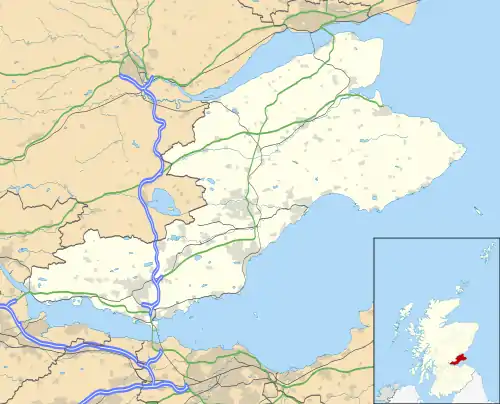Dunfermline City Chambers
Dunfermline City Chambers is a municipal facility at the corner of Bridge Street and Kirkgate in Dunfermline, Fife. The building, which serves as home to the local area committee of Fife Council, is a Category A listed building.[1]
| Dunfermline City Chambers | |
|---|---|
.jpg.webp) Dunfermline City Chambers | |
| Location | 3 Bridge Street, Dunfermline |
| Coordinates | 56.0708°N 3.4640°W |
| Built | 1879 |
| Architect | James Campbell Walker |
| Architectural style(s) | French Gothic style |
Listed Building – Category A | |
| Designated | 12 January 1971 |
| Reference no. | LB25973 |
 Shown in Fife | |
History
The building was commissioned to replace the old town house in Bridge Street which had been completed in 1771.[2] After rapid industrial growth in the local area,[3] civic leaders decided they needed a more substantial facility and the old town house was demolished, to make way for the current building.[2]
The foundation stone for the new building was laid on 11 October 1876.[2] It was designed by James Campbell Walker in the French Gothic style, built by Messrs W & J Hutchison and completed in May 1879.[4] The design involved an asymmetrical main frontage with twelve bays facing onto Kirkgate; the southern section featured a doorway with an octagonal turret above in the south east corner, while the northern section featured an elaborate doorway with a balcony and prominent four-face clock tower with bartizans in the north east corner.[1] The structure included heraldic stones, recovered from the demolished 18th century town house, which may have originated from the now derelict Dunfermline Palace, a few hundred yards to the south.[5] The stonework on the Bridge Street façade included busts of Malcolm Canmore, Queen Margaret, Robert the Bruce and Elizabeth de Burgh.[6] Internally, the principal room was the council chamber on the first floor: it incorporated an oak hammerbeam roof.[1] There were police cells in the basement of the building.[6]
The building was the headquarters of the royal burgh of Dunfermline until it was replaced by Dunfermline District under the wider Fife Regional Council in May 1975.[7][8] The building ceased to be a seat of government after the district council was abolished in 1996, under the Local Government etc. (Scotland) Act 1994.[9] Since then, the building has served as the home of the local area committee of Fife Council,[10] as a venue for marriages and civil partnerships[11] and as the local registration office.[12]
Works of art in the city chambers include Sir Joseph Paton's painting of Queen Margaret and Malcolm Canmore.[13][14]
See also
References
- Historic Environment Scotland. "3 Bridge Street, City Chambers (Category A Listed Building) (LB25973)". Retrieved 13 April 2020.
- "History of Bridge Street" (PDF). Royal Dunfermline. pp. 13–18. Retrieved 13 April 2020.
- Simpson, Eric (1987). The Auld Grey Toun – Dunfermline in the time of Andrew Carnegie 1835–1919. Carnegie Dunfermline Trust. p. 85. ISBN 978-0947559090.
- Beattie, George. "James Stewart & Sons, Builders & Quarrymasters". Dunfermline Historical Society. Retrieved 13 April 2020.
- "Ten town halls to visit". The Telegraph. 29 November 2008. Retrieved 13 April 2020.
- "Dunfermline Guide Book" (PDF). p. 34.
- "Local Government (Scotland) Act 1973". Legislation.gov.uk. Retrieved 16 April 2020.
- McEwan Bert Dunfermline: The Post-War Years p.16.
- "Local Government etc (Scotland) Act 1994". Legislation.co.uk. Retrieved 13 April 2020.
- "Baby Jamie snoozes through his first council meeting". The Courier. 8 September 2016. Retrieved 14 April 2020.
- "Weddings in Fife" (PDF). Fife Council. p. 8. Retrieved 23 September 2020.
- "Dunfermline Customer Service Centre - City Chambers". Fife Council. Retrieved 23 September 2020.
- "The Patons of Dunfermline". Royal Scottish Academy. 26 June 2020. pp. 22–23. Retrieved 23 September 2020.
- Paton, Joseph Noel. "Queen Margaret and King Malcom Canmore". Art UK. Retrieved 23 September 2020.
Further reading
- McEwan, Bert (1998), Dunfermline: Our Heritage